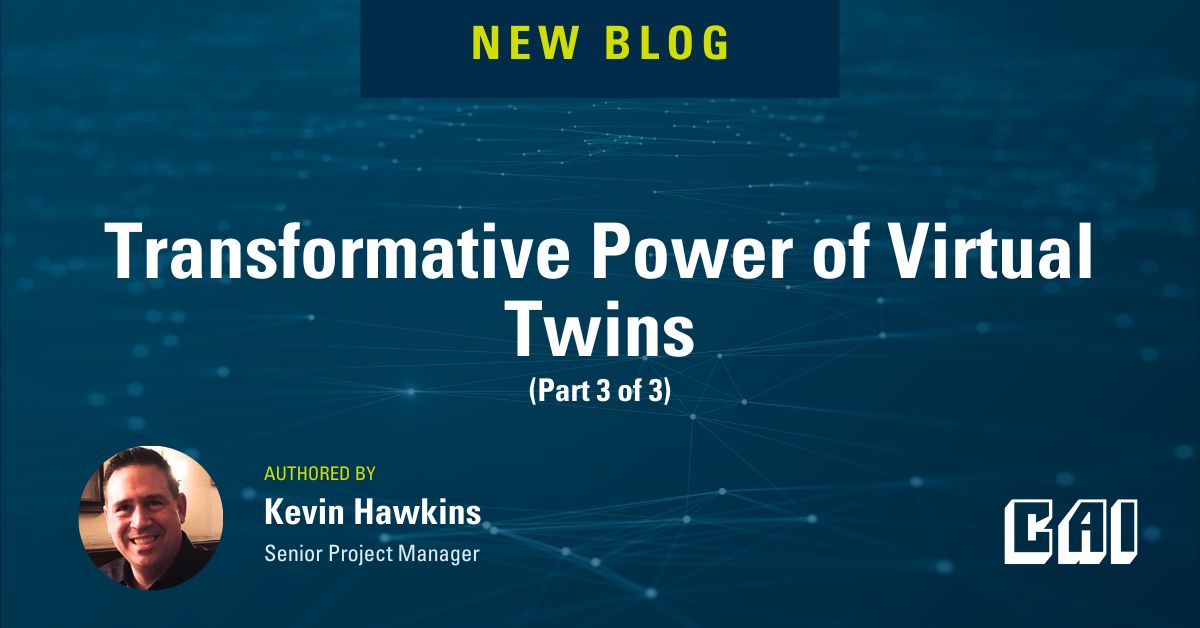
Transformative Power of Virtual Twins (Part 3 of 3)
This is the final installment of a three-part series exploring the transformative power of Virtual Twins as part of an asset induction effort for facility maintenance. The information in this series is based on the use of Virtual Twin technology for a biomanufacturing site, but the same principles could be applied to any facility that is looking to leverage a digital twin for their facility.
Part One of this series provided an overview of implementation of this technology and benefits once completed. In Part Two we addressed the process of capturing and modeling data to build the Virtual Twin, and the Project Management tools used to ensure all required deliverables were accomplished. Now in Part Three we will focus on the project management aspects of asset induction and the advantages that can be gained by using this emerging technology.
Part Three – Leveraging Virtual Twin for Improved Project Oversight.
Project Management Benefits of Virtual Twins as part of Asset Induction:
Implementing a virtual twin technology as part of an asset induction effort can provide several benefits to project managers and facilitates execution of cost-efficient projects that deliver a high-quality product on an accelerated timeline. It allows project managers to visualize the entire project lifecycle, identify potential issues and explore different scenarios in a virtual environment.
Comprehensive Asset Understanding:
- Virtual Twin Technology allows project managers to create highly detailed and accurate digital replicas of physical assets. This enables stakeholders to gain a comprehensive understanding of the assets, including their design, configuration, components, and operational characteristics.
Efficient Training and Onboarding:
- Virtual Twin Technology facilitates realistic training simulations for operators, technicians, and maintenance personnel. Project managers can use virtual replicas to provide hands-on training experiences, simulate various operational scenarios, and familiarize users with asset functionalities, controls, and maintenance procedures.
Enhanced Safety and Risk Management:
- Virtual Twin Technology enables project managers to identify potential safety hazards, operational risks, and compliance issues associated with the assets. By conducting virtual risk assessments and simulations, they can develop effective safety protocols, emergency response plans, and mitigation strategies to ensure safe asset operation and minimize operational disruptions.
Optimized Maintenance and Lifecycle Management:
- Virtual Twin Technology supports predictive maintenance capabilities by integrating real-time sensor data and analytics into the virtual model. Project managers can monitor asset performance, detect anomalies, and predict potential failures before they occur. This proactive approach helps optimize maintenance schedules, minimize downtime, and extend the lifecycle of critical assets.
Improved Collaboration and Decision-Making:
- Virtual Twin technology fosters collaboration among cross-functional teams involved in asset induction, including engineering, operations, maintenance, and regulatory compliance. Project managers can leverage the virtual model to facilitate communication, coordinate activities, and make informed decisions based on shared insights and data-driven analytics.
Streamlined Commissioning and Deployment:
- Virtual Twin Technology accelerates the commissioning and deployment process by enabling project managers to simulate asset configurations, test integration with existing systems, and validate performance in a virtual environment. This reduces the time and resources required for physical commissioning, minimizes commissioning errors, and ensures smoother deployment of assets into operational environments.
Continuous Improvement and Innovation:
- Virtual Twin Technology supports continuous improvement initiatives by providing valuable data and insights throughout the asset lifecycle. Project managers can analyze performance metrics, identify optimization opportunities, and drive innovation in asset design, operation, and maintenance processes to enhance productivity, efficiency, and sustainability.
Conclusion:
By leveraging Virtual Twin Technology as part of an Asset Induction effort, project managers can optimize asset performance, minimize risks, and maximize the value of investments while ensuring safe, efficient, and reliable operation throughout the asset lifecycle. Overall, implementing Virtual Twin Technology empowers project managers with advanced tools and capabilities to plan, execute, and manage projects more effectively, ultimately driving better outcomes and delivering greater value to stakeholders.
As the biomanufacturing industry continues to evolve, embracing innovative solutions like Virtual Twin scans is essential for staying competitive and ensuring the seamless integration of assets into the production ecosystem.
Tags: digital tools, digital transformation, asset management, reliability, maintanence, virtual twin, computerized maintenance


